Note
Go to the end to download the full example code.
Circuit: AMI PostProcessing#
This example shows how you can use PyAEDT to perform advanced postprocessing of AMI simulations.
Perform required imports#
Perform required imports and set the local path to the path for PyAEDT.
# sphinx_gallery_thumbnail_path = 'Resources/spectrum_plot.png'
import os
from matplotlib import pyplot as plt
import numpy as np
import pyaedt
# Set local path to path for PyAEDT
temp_folder = pyaedt.generate_unique_folder_name()
project_path = pyaedt.downloads.download_file("ami", "ami_usb.aedtz", temp_folder)
Set AEDT version#
Set AEDT version.
aedt_version = "2024.2"
Set non-graphical mode#
Set non-graphical mode.
You can set non_graphical either to True or False.
The Boolean parameter new_thread defines whether to create a new instance
of AEDT or try to connect to an existing instance of it.
non_graphical = False
NewThread = True
Launch AEDT with Circuit and enable Pandas as the output format#
All outputs obtained with the get_solution_data method will have the Pandas format.
Launch AEDT with Circuit. The pyaedt.Desktop class initializes AEDT
and starts the specified version in the specified mode.
pyaedt.settings.enable_pandas_output = True
cir = pyaedt.Circuit(project=os.path.join(project_path), non_graphical=non_graphical,
version=aedt_version, new_desktop=NewThread)
C:\actions-runner\_work\_tool\Python\3.10.9\x64\lib\subprocess.py:1072: ResourceWarning: subprocess 10208 is still running
_warn("subprocess %s is still running" % self.pid,
C:\actions-runner\_work\pyaedt\pyaedt\.venv\lib\site-packages\pyaedt\generic\settings.py:437: ResourceWarning: unclosed file <_io.TextIOWrapper name='D:\\Temp\\pyaedt_ansys_e6365f2f-3b8c-40bb-8a68-3f4e6e7c8dd5.log' mode='a' encoding='cp1252'>
self._logger = val
Solve AMI setup#
Solve the transient setup.
cir.analyze()
True
Get AMI report#
Get AMI report data
plot_name = "WaveAfterProbe<b_input_43.int_ami_rx>"
cir.solution_type = "NexximAMI"
original_data = cir.post.get_solution_data(expressions=plot_name, domain="Time",
variations=cir.available_variations.nominal)
original_data_value = original_data.full_matrix_real_imag[0]
original_data_sweep = original_data.primary_sweep_values
print(original_data_value)
C:\actions-runner\_work\pyaedt\pyaedt\.venv\lib\site-packages\pandas\core\arraylike.py:399: RuntimeWarning: invalid value encountered in sqrt
result = getattr(ufunc, method)(*inputs, **kwargs)
WaveAfterProbe<b_input_43.int_ami_rx>
0.000000 -553.298382
0.003125 -553.298382
0.006250 -553.298382
0.009375 -553.298382
0.012500 -553.298382
... ...
99.984375 -25.138119
99.987500 19.046320
99.990625 60.268984
99.993750 98.348353
99.996875 133.328724
[32000 rows x 1 columns]
Plot data#
Create a plot based on solution data.
fig = original_data.plot()

Sample WaveAfterProbe waveform using receiver clock#
Extract waveform at specific clock time plus half unit interval
probe_name = "b_input_43"
source_name = "b_output4_42"
plot_type = "WaveAfterProbe"
setup_name = "AMIAnalysis"
ignore_bits = 100
unit_interval = 0.1e-9
sample_waveform = cir.post.sample_ami_waveform(setup=setup_name, probe=probe_name, source=source_name,
variation_list_w_value=cir.available_variations.nominal,
unit_interval=unit_interval, ignore_bits=ignore_bits,
plot_type=plot_type)
C:\actions-runner\_work\pyaedt\pyaedt\.venv\lib\site-packages\pandas\core\arraylike.py:399: RuntimeWarning: invalid value encountered in sqrt
result = getattr(ufunc, method)(*inputs, **kwargs)
Plot waveform and samples#
Create the plot from a start time to stop time in seconds
tstop = 55e-9
tstart = 50e-9
scale_time = pyaedt.constants.unit_converter(1, unit_system="Time", input_units="s",
output_units=original_data.units_sweeps["Time"])
scale_data = pyaedt.constants.unit_converter(1, unit_system="Voltage", input_units="V",
output_units=original_data.units_data[plot_name])
tstop_ns = scale_time * tstop
tstart_ns = scale_time * tstart
for time in original_data_value[plot_name].index:
if tstart_ns <= time[0]:
start_index_original_data = time[0]
break
for time in original_data_value[plot_name][start_index_original_data:].index:
if time[0] >= tstop_ns:
stop_index_original_data = time[0]
break
for time in sample_waveform[0].index:
if tstart <= time:
sample_index = sample_waveform[0].index == time
start_index_waveform = sample_index.tolist().index(True)
break
for time in sample_waveform[0].index:
if time >= tstop:
sample_index = sample_waveform[0].index == time
stop_index_waveform = sample_index.tolist().index(True)
break
original_data_zoom = original_data_value[start_index_original_data:stop_index_original_data]
sampled_data_zoom = sample_waveform[0].values[start_index_waveform:stop_index_waveform] * scale_data
sampled_time_zoom = sample_waveform[0].index[start_index_waveform:stop_index_waveform] * scale_time
fig, ax = plt.subplots()
ax.plot(sampled_time_zoom, sampled_data_zoom, "r*")
ax.plot(np.array(list(original_data_zoom.index.values)), original_data_zoom.values)
ax.set_title('WaveAfterProbe')
ax.set_xlabel(original_data.units_sweeps["Time"])
ax.set_ylabel(original_data.units_data[plot_name])
plt.show()
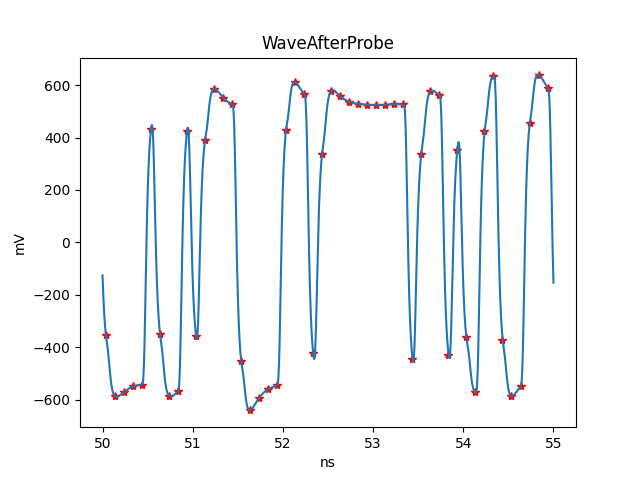
Plot Slicer Scatter#
Create the plot from a start time to stop time in seconds
fig, ax2 = plt.subplots()
ax2.plot(sample_waveform[0].index, sample_waveform[0].values, "r*")
ax2.set_title('Slicer Scatter: WaveAfterProbe')
ax2.set_xlabel("s")
ax2.set_ylabel("V")
plt.show()
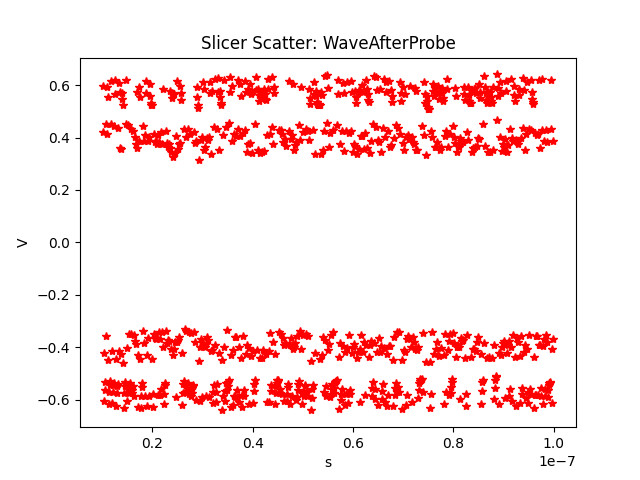
Plot scatter histogram#
Create the plot from a start time to stop time in seconds.
fig, ax4 = plt.subplots()
ax4.set_title('Slicer Histogram: WaveAfterProbe')
ax4.hist(sample_waveform[0].values, orientation='horizontal')
ax4.set_ylabel("V")
ax4.grid()
plt.show()
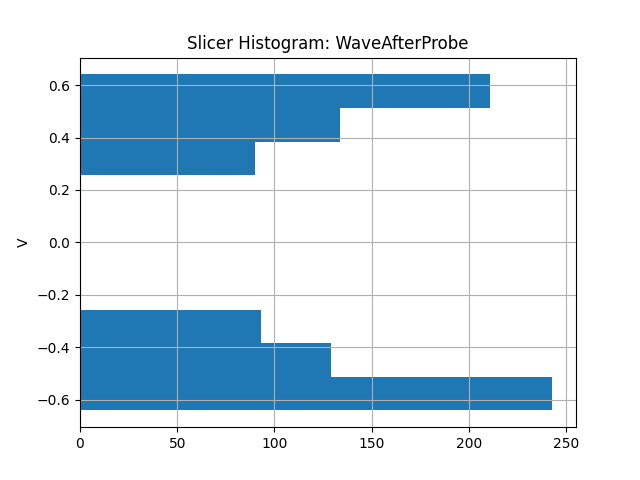
Get Transient report#
Get Transient report data
C:\actions-runner\_work\pyaedt\pyaedt\.venv\lib\site-packages\pandas\core\arraylike.py:399: RuntimeWarning: invalid value encountered in sqrt
result = getattr(ufunc, method)(*inputs, **kwargs)
Sample waveform using a user-defined clock#
Extract waveform at specific clock time plus half unit interval.
original_data.enable_pandas_output = False
original_data_value = original_data.data_real()
original_data_sweep = original_data.primary_sweep_values
waveform_unit = original_data.units_data[plot_name]
waveform_sweep_unit = original_data.units_sweeps["Time"]
tics = np.arange(20e-9, 100e-9, 1e-10, dtype=float)
sample_waveform = cir.post.sample_waveform(
waveform_data=original_data_value,
waveform_sweep=original_data_sweep,
waveform_unit=waveform_unit,
waveform_sweep_unit=waveform_sweep_unit,
unit_interval=unit_interval,
clock_tics=tics,
pandas_enabled=False,
)
Plot waveform and samples#
Create the plot from a start time to stop time in seconds.
tstop = 40.0e-9
tstart = 25.0e-9
scale_time = pyaedt.constants.unit_converter(1, unit_system="Time", input_units="s",
output_units=waveform_sweep_unit)
scale_data = pyaedt.constants.unit_converter(1, unit_system="Voltage", input_units="V",
output_units=waveform_unit)
tstop_ns = scale_time * tstop
tstart_ns = scale_time * tstart
for time in original_data_sweep:
if tstart_ns <= time:
start_index_original_data = original_data_sweep.index(time)
break
for time in original_data_sweep[start_index_original_data:]:
if time >= tstop_ns:
stop_index_original_data = original_data_sweep.index(time)
break
cont = 0
for frame in sample_waveform:
if tstart <= frame[0]:
start_index_waveform = cont
break
cont += 1
for frame in sample_waveform[start_index_waveform:]:
if frame[0] >= tstop:
stop_index_waveform = cont
break
cont += 1
original_data_zoom = original_data_value[start_index_original_data:stop_index_original_data]
original_sweep_zoom = original_data_sweep[start_index_original_data:stop_index_original_data]
original_data_zoom_array = np.array(list(map(list, zip(original_sweep_zoom, original_data_zoom))))
original_data_zoom_array[:, 0] *= 1
sampled_data_zoom_array = np.array(sample_waveform[start_index_waveform:stop_index_waveform])
sampled_data_zoom_array[:, 0] *= scale_time
sampled_data_zoom_array[:, 1] *= scale_data
fig, ax = plt.subplots()
ax.plot(sampled_data_zoom_array[:, 0], sampled_data_zoom_array[:, 1], "r*")
ax.plot(original_sweep_zoom, original_data_zoom_array[:, 1])
ax.set_title(plot_name)
ax.set_xlabel(waveform_sweep_unit)
ax.set_ylabel(waveform_unit)
plt.show()
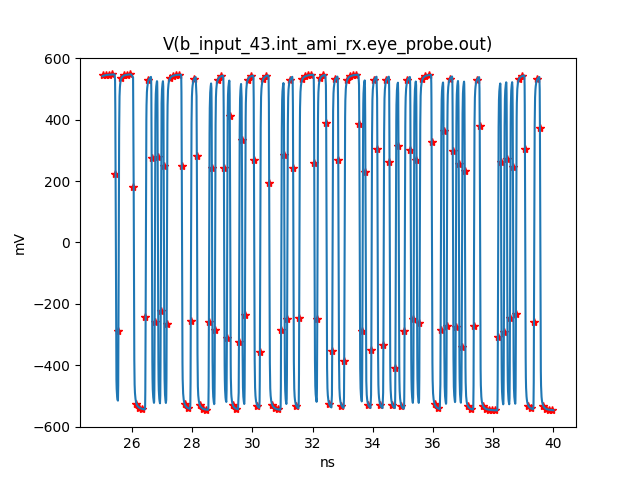
Plot slicer scatter#
Create the plot from a start time to stop time in seconds.
sample_waveform_array = np.array(sample_waveform)
fig, ax2 = plt.subplots()
ax2.plot(sample_waveform_array[:, 0], sample_waveform_array[:, 1], "r*")
ax2.set_title('Slicer Scatter: ' + plot_name)
ax2.set_xlabel("s")
ax2.set_ylabel("V")
plt.show()
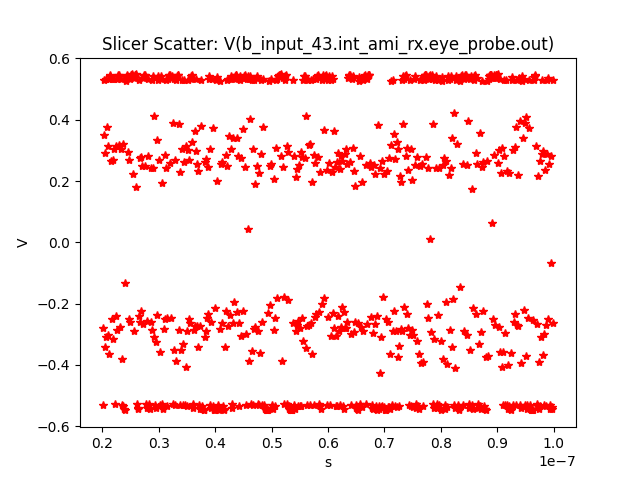
Save project and close AEDT#
Save the project and close AEDT.
cir.save_project()
print("Project Saved in {}".format(cir.project_path))
cir.release_desktop()
Project Saved in D:/Temp/pyaedt_prj_2ZA/ami/
True
Total running time of the script: (1 minutes 8.789 seconds)